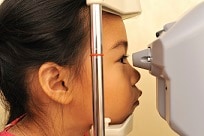
Resources
- Bright Futures/AAP
- American Academy of Ophthalmology
- USPSTF Recommendations
- Vision Services for Children on Medicaid
- National Center for Children's Vision and Eye Health
- Joint Committee on Infant Hearing
- EHDI Programs
- American Speech- Language-Hearing Association
- American Academy of Audiology
- Hearing Services for Children on Medicaid

Featured Resources
Children and adolescents enrolled in Medicaid should receive both vision and hearing screenings at each well-child check-up. If a primary care provider suspects that a child has a vision or hearing problem, the child should receive further evaluation and necessary treatment. Medicaid coverage for children and adolescents provides low-income children and adolescents many services that can detect and address vision and hearing problems.
State Medicaid agencies can take simple, concrete steps to ensure that enrolled children and adolescents receive these vision and hearing services. States should review their Medicaid benefits for children and adolescents to make sure that vision and hearing screening schedules and content are up-to-date, methods for informing enrollees about benefits are effective, and procedures are in place to ensure referral to and tracking of vision and hearing services.
Why are Vision and Hearing Screenings and Services so Important?
About a quarter of all school-aged children have a significant vision problem. Too few children receive the vision screening services that they need, which means that they go through childhood with untreated visual impairment. Common childhood eye conditions include nearsightedness, lazy eye (amblyopia), and misalignment of the eyes (strabismus). Left untreated, these eye conditions can create far-reaching and long-lasting consequences. In fact, amblyopia is the most common cause of single eye vision loss among adults 20 to 70 years old.
Two to three out of every 1,000 children are born with hearing impairments, which can range from mild to profound. Many more children develop hearing problems after birth. These problems can have a negative impact on language and speech development, academic performance, and overall well-being. Research shows that identifying and treating hearing impairments early – before 6 months of age – can help prevent these outcomes.
Although over 95 percent of all newborns receive a hospital-based hearing screening shortly after birth through state Early Hearing Detection and Intervention programs, many children with impaired hearing are not receiving early diagnosis and treatment for hearing conditions. Data from the Centers for Disease Control and Prevention suggest that half of the newborns who fail a routine hearing screening do not get further diagnostic testing to determine whether their hearing is impaired or normal. Of the newborns diagnosed with hearing problems, more than 30 percent do not receive early intervention services. In addition, newborn hearing screening cannot identify all types of hearing problems, and children can develop hearing impairments long after birth. Recent research indicates that the rate of hearing problems among adolescents is increasing. However, the same Office of Inspector General report indicates that, in the nine states studied, 67 percent of children enrolled in Medicaid did not receive recommended hearing screening services.
| Eye Condition | Definition |
|---|---|
| Amblyopia | Poor vision in an otherwise normal appearing eye that occurs when the brain does not fully recognize sight from that eye. Common causes are strabismus and refractive errors. |
| Strabismus | Misalignment of the eyes in any direction, including the inability to direct two eyes in the same direction. |
| Refractive Errors | The most common vision problem of childhood, often nearsightedness and/or astigmatism. |
| Binocular Vision Disorders | These include convergence insufficiency and ill-sustained accommodation. |
Vision and Hearing Screening and Treatment Requirements in the Medicaid Benefit for Children and Adolescents
Periodicity Schedule
AA periodicity schedule shows the ages when a child should receive screening services. States must adopt periodicity schedules for vision and hearing screening that meet reasonable standards of medical practice. States also should update the schedules as necessary to stay current with published guidelines. When adopting or updating a periodicity schedule, states must consult with recognized medical organizations involved in child health care, such as the American Academy of Pediatrics (AAP).
In addition to periodic screenings, children are entitled to receive “interperiodic” screenings whenever a provider, a parent, or a health, developmental, or educational professional suspects a possible problem.
Content of the Screening
States must set standards for conducting and documenting age-appropriate vision and hearing assessments. CMS has directed states to consult with ophthalmologists, optometrists, and audiologists to determine screening procedures to use and the criteria for determining when a child is referred for diagnostic examination.
Diagnosis and Treatment
When a screening shows possible vision or hearing problems the child should be referred for further evaluation. EPSDT requires Medicaid coverage of necessary diagnostic and treatment services, including further testing, eyeglasses, hearing aids, replacement batteries, and cochlear implants, even if the services are not covered for adults. States must arrange for treatment, and the treatment must be provided with reasonable promptness.
States Must Inform Enrollees About the Medicaid Benefit for Children and Adolescents
States must inform eligible children and their families about the following:
- The importance of preventive care;
- The services available and how and where to obtain the services;
- That the services are available without cost, or if there is a cost, how much; and
- That transportation and help with scheduling appointments are available upon request.
Under both Medicaid and CHIP, there is never a charge for well-child visits. States must provide information using clear and nontechnical language within 60 days after an individual or family is determined eligible for Medicaid, as well as annually thereafter. States must also inform Medicaid-eligible pregnant women about the availability of the Medicaid benefit for children and adolescents.
For examples of written materials that states use to inform eligible children and their families, see Minnesota’s Child and Teen Checkups brochure and Illinois’s Healthy Kids Checkups brochure.
References
CMS, EPSDT – A Guide for States: Coverage of the Medicaid Benefit for Children and Adolescents (2014).

